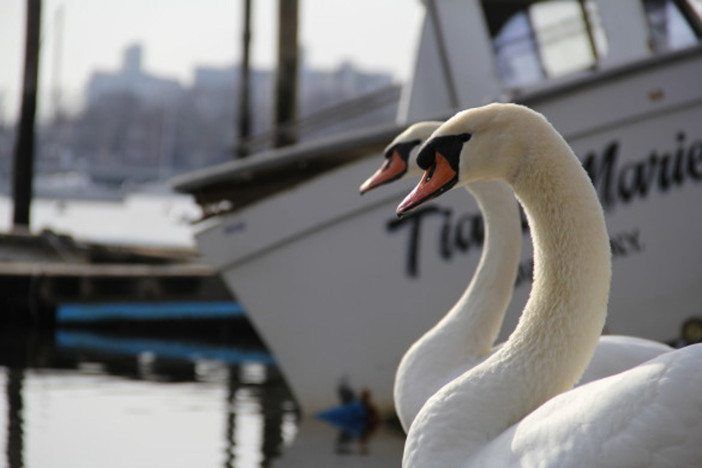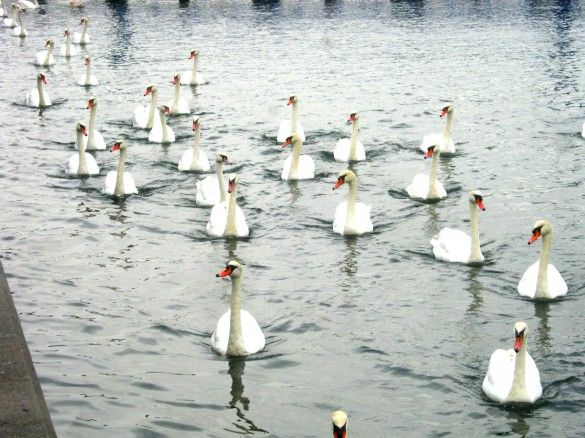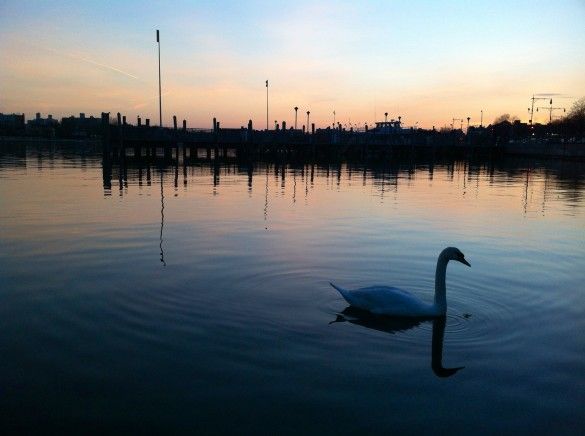Sheepshead Bay’s Iconic Swans Back On State’s Kill List, Sort Of


The state has released a new plan to manage the booming mute swan population, telling critics that if they don’t want to see the swans killed then they have to pay to keep them around.
The revised plan, released Monday by the state Department of Environmental Conservation, comes after a December 2013 plan to wipe out all of New York’s 2,200 mute swans, the large white bird that’s become an icon of the Sheepshead Bay waterfront.

The original plan called for gassing or shooting most of the adult population, and addling or oiling eggs to prevent a new generation from popping up. The lethal methods drew outcry from animal rights activists and elected officials, despite the agency’s insistence that the European swans are invasive species damaging the habitat of native flora and fauna.
[pullquote]”Complete elimination of mute swans from New York is not a viable option given the expressed public opinions associated with these birds.” – DEC revised draft plan[/pullquote]
The agency pulled the plans in March after it received more than 1,500 comments, 16,000 form letters and 30,000 petition signatures, with the DEC promising sensitivity to “regional differences … and desired population goals” in specific communities.
The new draft, which can be read here, acknowledges the widespread outcry with frequent references to “expressed public opinion,” and noting that “many people enjoy seeing [the swans] despite adverse impacts the birds can cause.”
But the document also notes that areas that once had a handful of the birds are now home to hundreds. The population was estimated at approximately 500 birds in the 1970s and is more than 2,000 birds today.

The new plan continues to recommend their elimination, but notes it’s not possible given the public support the birds enjoy.
“Complete elimination of mute swans from New York is not a viable option given the expressed public opinions associated with these birds,” the new draft plan states.
Instead, the DEC leaves a survival option for the majority of swans who live in downstate areas like Sheepshead Bay: pay to manage the population.
… many people object to the use of lethal control methods, especially killing adult birds…
… Placement and proper care of swans in public parks or other controlled settings can be costly to local governments or communities, but if people who enjoy seeing mute swans are willing to support such programs, DEC will cooperate with those efforts.
The agency proposes allowing local governments to come up with their own management plan to keep population numbers from continuing to swell, and even cull it down to 800 statewide. But that requires municipalities to pony up and cover the additional costs of implementing that plan.

Additionally, the plan pushes an education program to teach the public about the consequences of feeding the birds, and the risks their booming population poses on native environments.
The compromise is not winning over Assembyman Steven Cymbrowitz, who fought to protect the swans last year.
“This is not acceptable. DEC still hasn’t provided any additional evidence that mute swans pose a danger to other wildlife, people or the environment,” said Cymbrowitz. “And this insistence on making fiscally strapped municipalities responsible for managing the swan population humanely is a convenient way for DEC to justify killing the birds when localities fall short.”
Cymbrowitz introduced legislation last year that would place a two-year moratorium on implementing the DEC’s plan, and require at least two public hearings before it’s adopted. The plan, sponsored by Queens State Senator Tony Avella in the Senate, was passed and ultimately vetoed by Governor Andrew Cuomo. The legislation was reintroduced and is currently in committee.
Avella offered a more moderate approach, saying that he will decide whether to support or oppose it after a detailed review and consultation with stakeholders.



